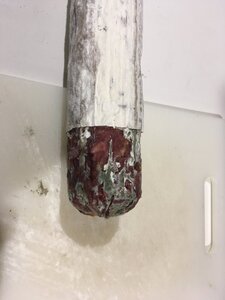Hello Domie.. Looks like there are a couple issues here. Synthetic casings can be a little finicky. Collagen or even fibrous. Even on great days these casings can separate in some areas. Protein lined casings tend to adhere a lot better but I find that adding enough salt and cure to your recipe and mixing till your batter gets extremely tacky tends to mitigate casing separation. One cool ingredient that really helps with binding is the addition of Non Fat Dry Powder Milk. Adding this to your salami mix also helps with good protein extraction which will give you a better bind. It also has cool benefits when it comes to fermentation but that's for a different thread

.
If your blades and plates were new and the meat was chilled I see no issue there unless it was too chilled and it bogged down your grinder as you were grinding it. This too can cause fat to smear, but as I look at your picture it doesn't look like that's the case. It looks to me that your meat could have used a tiny bit more mixing to pull a little more myocin out which would have helped it adhere better. With that being said your salami looks fine! If you hit your target weight loss, I would give it a wine or vinegar wash and enjoy that tasty goodness!
The other issue I see is humidity. At 85+ rH you will start to see all sorts of fun mold start to grow. Especially when there's air pockets between your meat and casing. Do you have a dehumidifier in your chamber? Also do you have a humidifier in your chamber? If so would you mind sharing the control settings with me..
Thanks.
I do use non fat dry milk powder.
meat/fat never hesitated the grinder.
possible I could have mixed it more? It was certainly tacky though?
chamber has heat/cool abilities and I'm using the inkbird dual controller. Temp runs between 53 and 57. No issues here.
Chamber has 2- evadry 1100 units in it and a humidifier. Controller is a inkbird dual controller. Issues here. I struggle to get the chamber under 85-86%
I'm struggling with the humdity so, I've unplugged the humidifier and removed it from the cabinet. (figured why have water sitting in there).
Also recalibrated all 3 humidity probes I have in there. (digiten electric, the inkbird, and the engbird battery powered record keeping probe), all are within 1% of each other.
This morning I tried something....
I have my temperature range setting on the inkbird set at a 3+- swing.
As we all know, the cooling turns on, the humidity drops. So, I got to thinking that maybe I'm running too long of an off cycle? So I tightened the range swing down to +1-3. So at todays temps here in Bama (67deg, 90%rh), the cooling component is cycling quicker. That has me running about 83% average humdidity. Better, but when temps change, this temporary fix is gonna go out the window.
One other thing... In 4 weeks time I have loaded 45-50 pounds of different product into a 30"x30"x5' Pepsi merchandise cooler space. Plenty of space between all of the hanging product but..... am I overloading the chamber?
One other thing. Today I lowered the fan speed on my computer fan by 40%. Thats evening out some of the wild swings.





